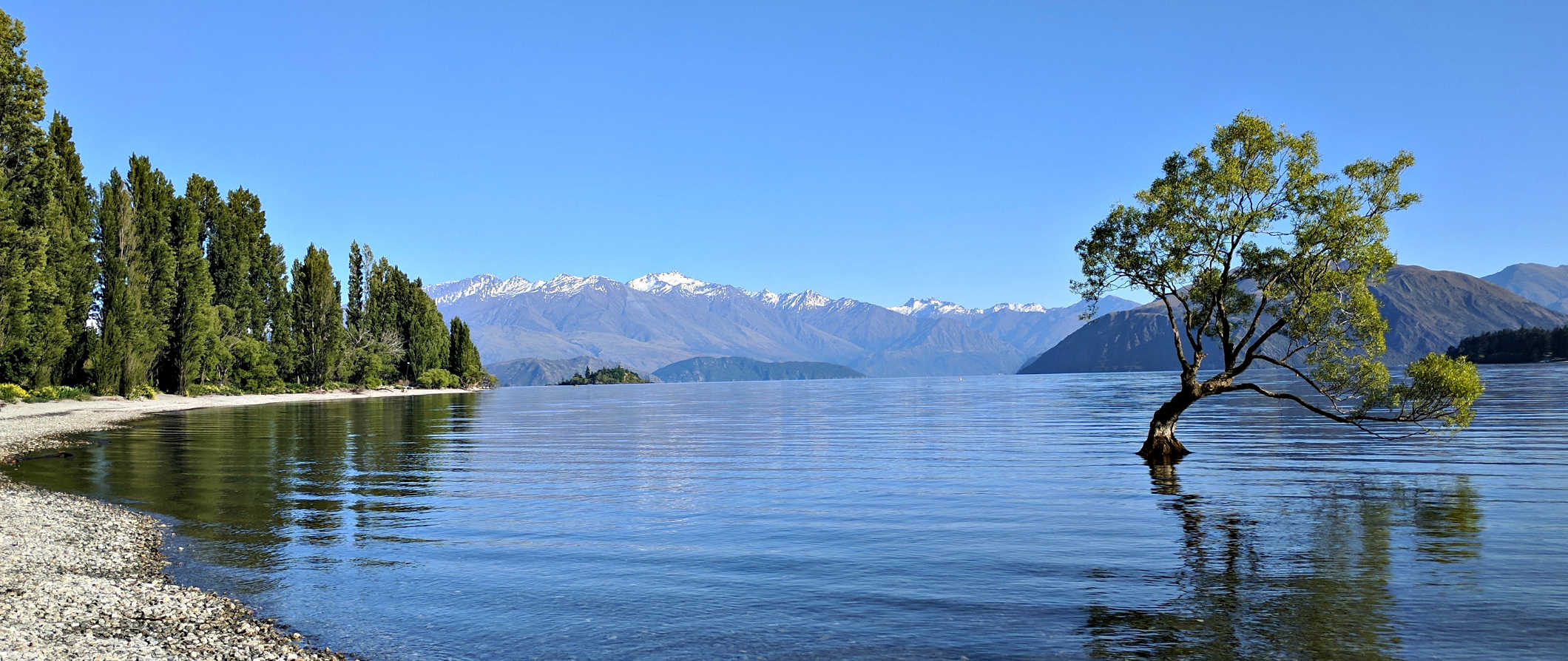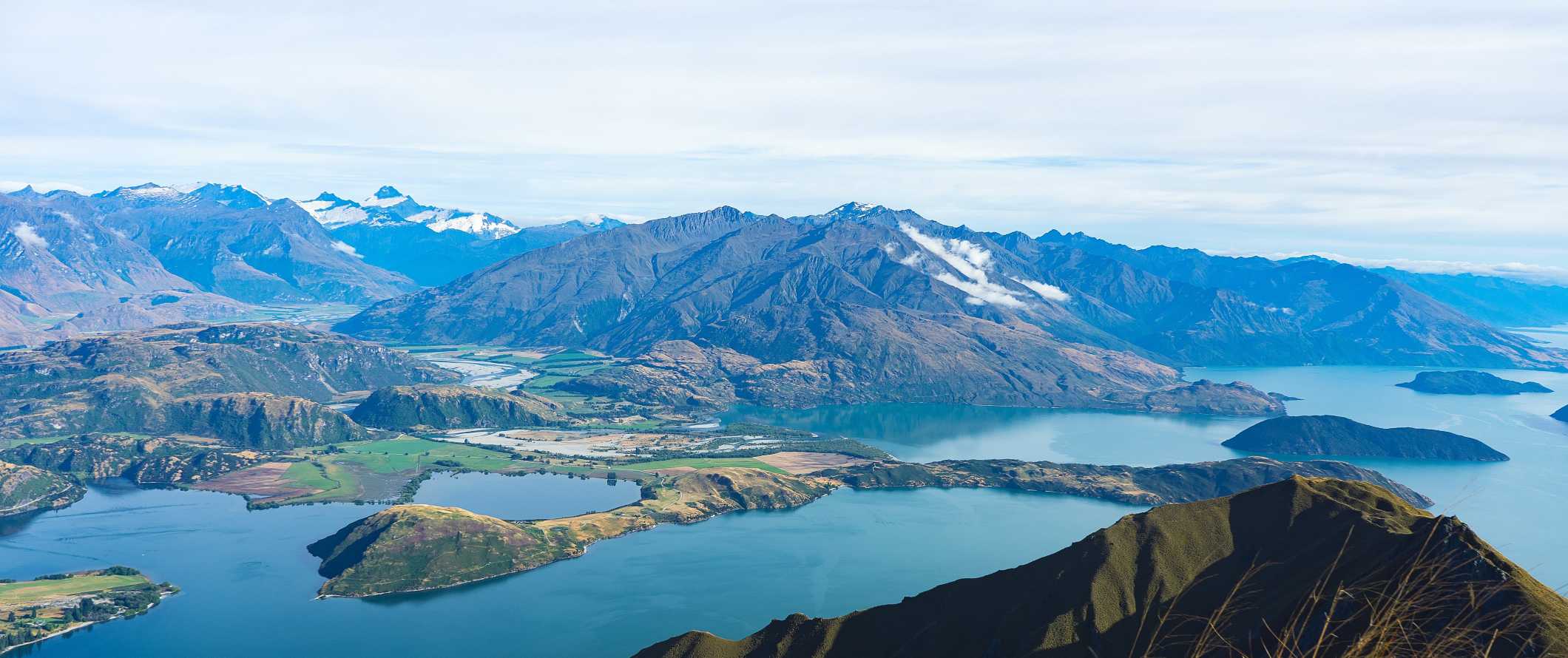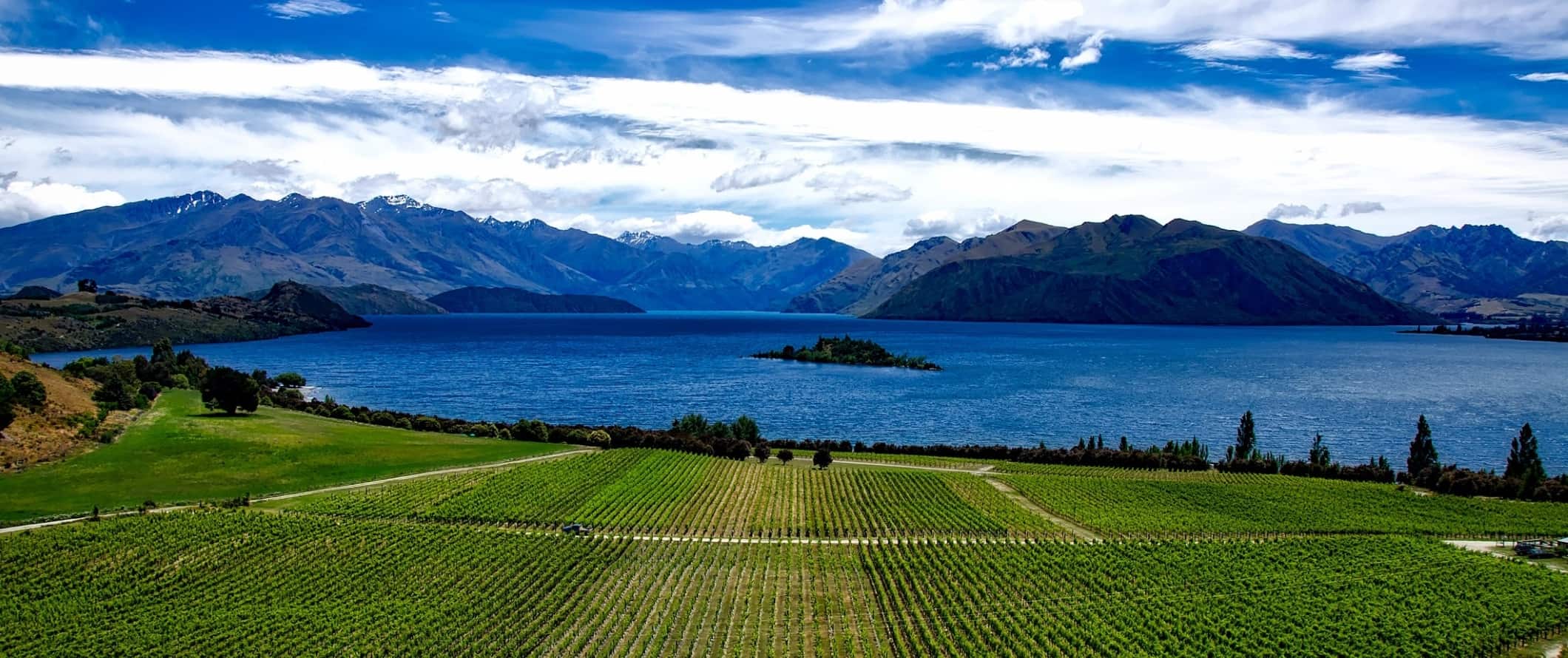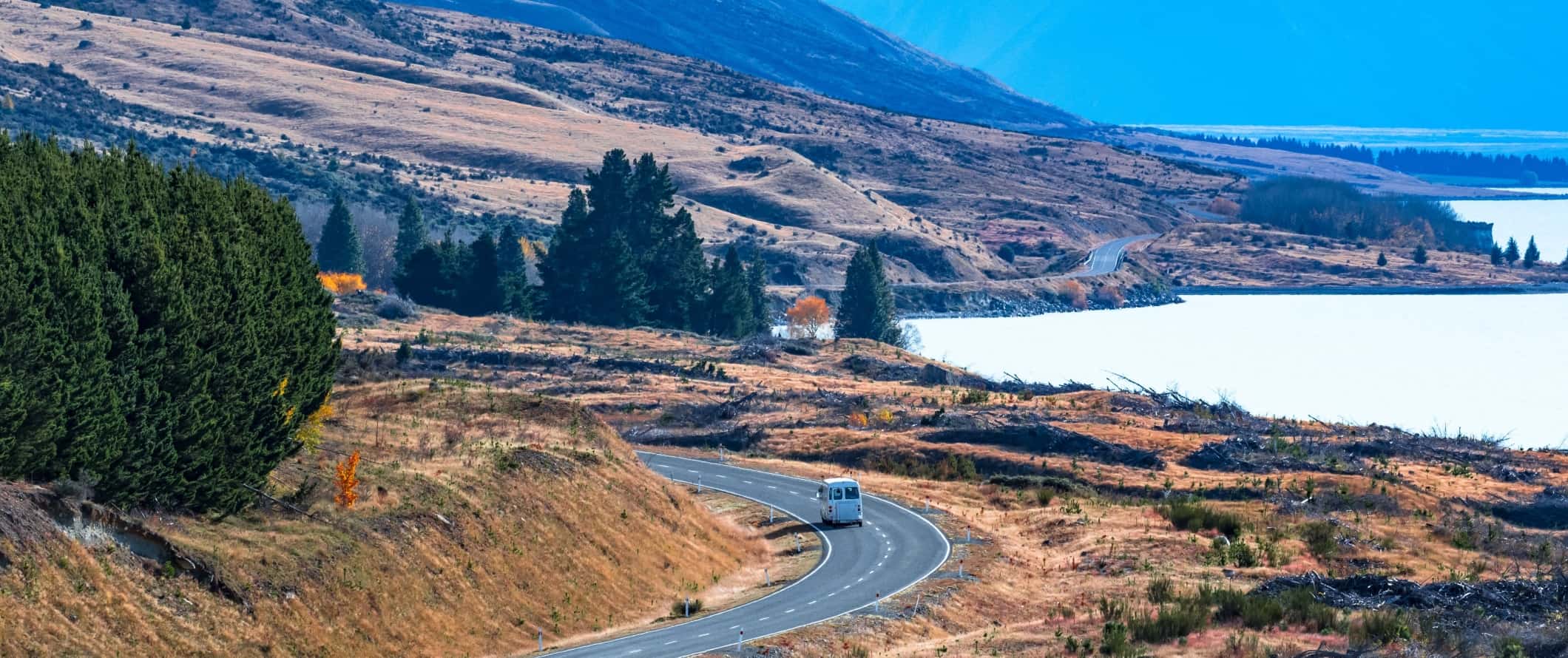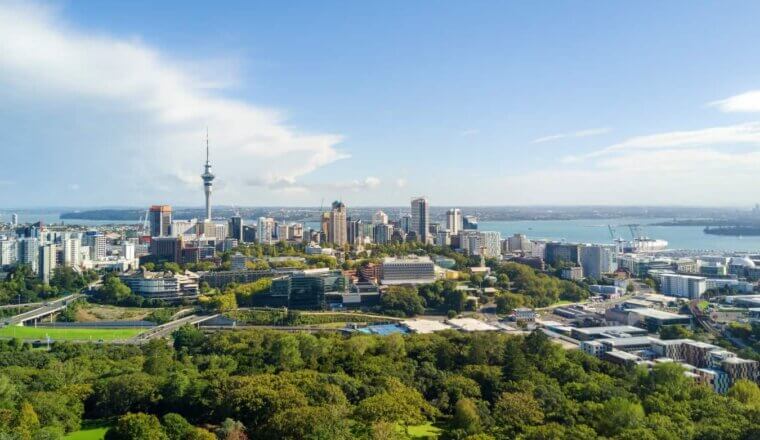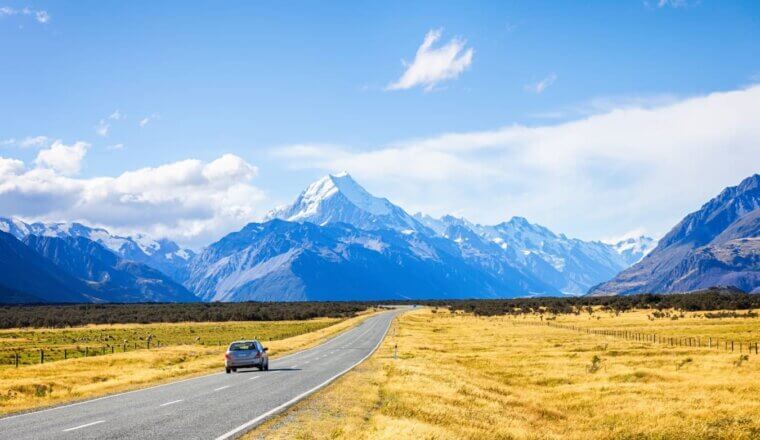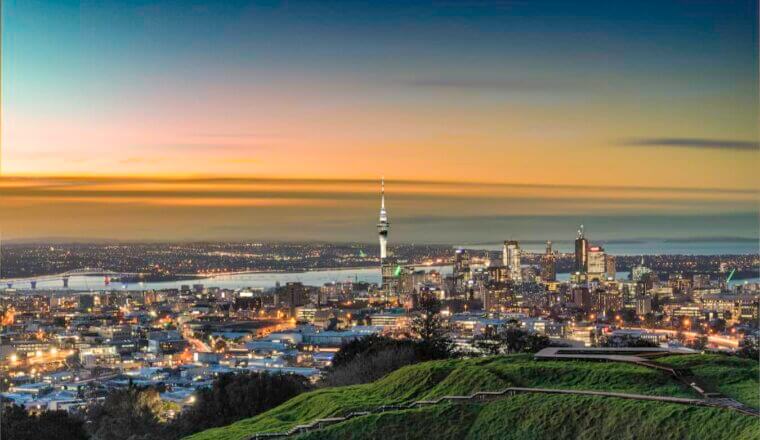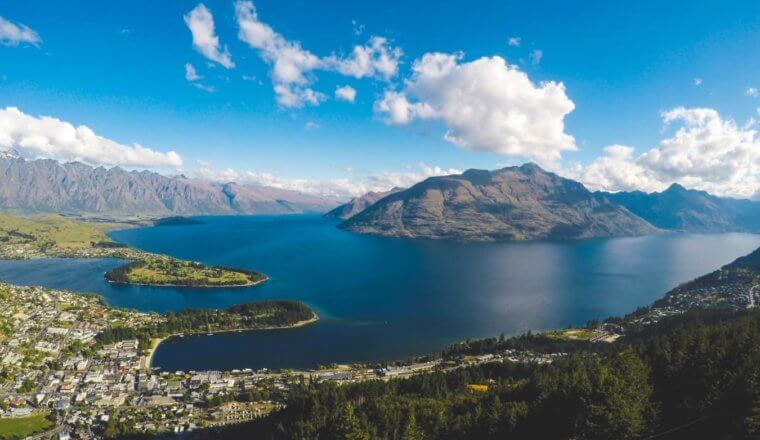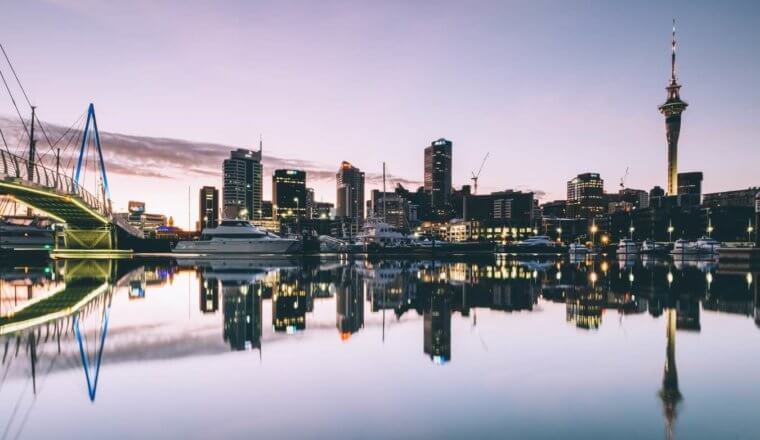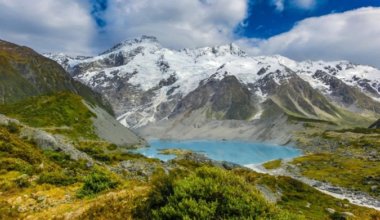Wanaka is a resort town on New Zealand’s South Island, set on Wanaka Lake and framed by snowcapped mountains.
From here you can explore the Southern Alps’ Mount Aspiring National Park, hike Rob Roy Glacier, go skiing, boat or kayak on the lake, hike one of the many trails around town, or just chill out. You’ll also find vineyards and wineries in the famed Otago Valley, home to mountains, dramatic skies, and picturesque lakes.
As nearby Queenstown has become overcrowded in recent years, travel to Wanaka has exploded and this sleepy little town has become popular with backpackers and outdoor enthusiasts.
It’s a really cool little town but there’s not a ton to do here beyond enjoying the outdoors. You can easily see everything in a day or two. Most people come here for a few nights to hike, relax, and move on.
This Wanaka travel guide will help you make the most of your time here — and help you save money in the process!
Table of Contents
Top 5 Things to See and Do in Wanaka
1. Go skiing
Wanaka is a big ski town, and if you’re a skier or snowboarder, you’ll definitely want to check out the Treble Cone, Snow Farm, and Cardrona ski resorts. They are all located within a 40-minute drive from Wanaka and offer excellent skiing/snowboarding. Lift passes start at 105 NZD per day or 175 NZD per day including equipment rental. Multi-day passes offer the best value for your money.
2. Trek Around Diamond Lake
Diamond Lake is a smaller lake located about a 20-minute drive from Wanaka. You can choose from several trails that go around the lake, including the 45-minute loop and a 1-hour hike to the lookout which affords incredible views over the surrounding lakes and mountains. Hiking is easy and suitable for all levels. For a longer hike, the Rocky Mountain Summit Track is 7 kilometers (4 miles) and takes 3 hours (return).
3. Explore Mount Aspiring National Park
Mount Aspiring National Park, part of the Te Wahipounamu World Heritage site, is full of pristine lakes, tall mountains, and epic glaciers. Its namesake mountain stands 3,000 meters (985 feet) tall in the middle of it all, covered in glaciers, waterfalls, rivers, and beech forest. There is excellent hiking here, including the 1-hour Blue Pools Track and the 4-hour Roby Roy Track. You can go to the Mount Aspiring Visitor Center in Wanaka before heading out to get detailed maps and tips.
4. Visit wineries
The climate here is ideal for growing grapes, and the primary wine in the area is Pinot Noir. The best way to see the wineries is to rent a car and go on your own. The nearby town of Cromwell has a self-guided 4 Barrels Walking Wine Trail, and Alexandra has the Pedal 4 Pinot Trail, which is a 25-kilometer (15-mile) loop in which you cycle to all the different wineries. You can also do a guided tour anytime throughout the year. If you decide to do a full-day tour, you’ll get to do some tastings in the Wanaka Region and then into Central Otago. However, I think that the wine tours are overpriced (they cost around 150 NZD for a 2-3 hour tour or 265 NZD for a full-day tour).
5. Hike Roy’s Peak
With beautiful Wanaka as the backdrop, you can climb to Roy’s Peak from lake-level through farmland and then up to the 1,578-meter (5,177-foot) summit. The peak offers spectacular views of Lake Wanaka, its islands, bays, and the snow-capped mountains of the Southern Alps/Tiritiri-o-te-Moana, including Mount Aspiring. It’s a 16-kilometer (10-mile) hike (return) that takes about 5-7 hours.
Other Things to See and Do in Wanaka
1. Visit Puzzling World
For some quirky fun, visit Puzzling World just outside town. It’s an outdoor maze and sculpture gallery that’s a quick and entertaining visit, especially if you have kids! It’s probably the best family activity in town. Admission to the maze is 18 NZD and the optical illusion space is 20 NZD. A combo ticket for both is 25 NZD.
2. Go horseback riding
Wanaka offers some of the best horse trekking in New Zealand. You can ride with cowboys in the high country and get an idea of what farm life is all about, or you can just enjoy an easy jaunt around Lake Wanaka. A ride along the Gold Discovery Trail in the Cardrona Valley is a great way to learn about the gold rush in the area as well, and you don’t need horseback riding experience to do it. Most two-hour group treks are 100-130 NZD.
4. Cruise Wanaka Lake
Take a boat cruise with Eco Wanaka to the remote and magical Mou Waho Island nature reserve, which is home to the rare flightless Buff Weka (extinct on the mainland since 1920). A one-hour guided bush walk is included, which takes you up to a lake right on top of the island! Tours last eight hours and cost 204 NZD. If you’d like to take a shorter cruise, Wanaka Cruises offers a one-hour cruise around the lake for 49 NZD, or a happy hour cruise for 59 NZD (which includes a drink).
5. Go jet boating on the Matukituki River
The glacial Matukituki River is the best place for experiencing river jet boating in New Zealand. Enjoy a 50-minute walk through remote moss-covered forest, waterfalls, and glacier-fed streams. Wander beneath Avalanche Glacier (when conditions permit) or into McGills Creek to explore one of the most beautiful and serene forest walks. Four-hour tours start at 239 NZD.
6. Bike the Glendhu Bay track
From Waterfall Creek the Glendhu Bay track follows the terraces above Lake Wanaka, offering spectacular views. Eventually, it leads to a small north-facing beach — Damper Bay — which is ideal for swimming in the summer. This first section of the track is hilly with some short, steep sections so you’ll want a reasonable level of fitness to do this. There are some really amazing views of Mount Aspiring from Glendhu Bay. You can rent mountain bikes in the area for about 50 NZD a day.
7. Attend the TUKI Festival
If you happen to be in Wanaka in February, attend the Tuki Festival (formerly the Rippon Festival). TUKI showcases some of the best New Zealand musical talent in a beautiful setting at Glendhu Bay. The stage is literally just 50 meters (165 feet) from the lake. A lot of people camp out at Glendhu Bay Motor Camp across the road, but you’ll have to book super quickly because all the spots sell out fast. Tickets start from around 140 NZD.
8. Hike Rob Roy Glacier
Take the Rob Roy Glacier Track into Mount Aspiring National Park, where you’ll get to experience the stunning mountains, glaciers, alpine lakes, and river valleys of the area. This route is an easy 10-kilometer (6-mile) trek, suitable even for children — and it’s doable in just a few hours. You should check ahead on the national park’s website to make sure there are no avalanche warnings or road closures. The hike starts at the Raspberry Creek car park which is about 54 kilometers (33 miles) west of Wanaka.
9. See Bremner Bay
Bremner Bay on Lake Wanaka is where the locals like to hang out, especially families who like to take advantage of the bay’s sheltered and shallow waters for swimming and picnicking in the warmer months. There’s a long, peaceful stretch of sandy white beach, and the water is clear and perfect for fishing and water sports. There isn’t a whole lot going on here; it’s definitely a place to relax!
10. Trek Mount Iron
This trek is just slightly more difficult than the Rob Roy Glacier Track, but it’s still an easy track. The hike itself is only 4.5 kilometers (2.8 miles) and shouldn’t take you longer than 90 minutes to do the whole loop. Mount Iron is a glacier-carved mountain rising 250 meters (820 feet) above the countryside, so when you reach the summit you’ll get panoramic views over the Pisa Range.
11. Walk the Outlet Track
The Outlet Track is an easy 3-kilometer (2.8-mile) walk following the clear waters of the Clutha River, stretching from the Lake Wanaka Outlet to Albert Town. It’s an easy route for families (even those with strollers), as well as cyclists and runners. It takes about an hour to do each way.
13. See the Famous Wanaka Tree
The Wanaka Willow is all that is left from a fence that is now on the shore of Lake Wanaka. It’s pretty overrated — it’s just a photogenic tree that got popular on Instagram. Talk about good marketing, right? But if you’re doing the lake walk, you’ll pass it so you might as well stop and snap a photo and tag #ThatWanakaTree!
For more information about other destinations in New Zealand, check out these guides!
Wanaka Travel Costs
Hostel prices – Hostel dorms cost between 35-40 NZD per night for a bed in a 4-6-bed dorm and 30-33 NZD per night in a dorm with 8 beds or more. Private rooms start at 65 NZD per night for a twin room with a shared bathroom. Free Wi-Fi is standard and most hostels here have kitchens for cooking your own meals. None offer free breakfast.
Camping in Wanaka is affordable with tent sites starting from 10 NZD per night for a basic plot (for two people) without electricity.
Budget hotel prices – Budget hotels and motels begin around 140 NZD per night, though most hotels in the area cost over 180 NZD. Expect free Wi-Fi, TV, and coffee/tea makers. Free breakfast is almost never included.
There are only a handful of Airbnb properties around Wanaka, with private rooms starting at 70-85 NZD per night. For an entire home or apartment, expect to pay at least 120 NZD.
Food – Food in Wanaka consists mostly of seafood, lamb, fish and chips, and meat pies. Expect to indulge on things like roast lamb, muscles, scallops, oysters, and snapper. Like everywhere else in the country, eating out here isn’t cheap (though it’s a little cheaper here than in other cities).
A meal of traditional cuisine costs around 20-25 NZD while a three-course restaurant meal with a drink costs about 40 NZD. There are no McDonald’s (or similar fast-food chains) here, and there are aren’t many affordable takeout places. You can find burritos, burgers, and pizza though, which all cost around 12-15 NZD.
Beer at the bar is 10-12 NZD, a glass of wine is 11-14 NZD, and a cocktail is 16-20 NZD. A latte/cappuccino costs 4.75 NZD while bottled water is 2.75 NZD.
If you choose to cook your food, plan to spend between 70-85 NZD per week for basic foodstuffs like rice, pasta, vegetables, and some meat. PaknSave is typically the cheapest supermarket.
Some of my favorite places to eat here are Federal Diner, Tititea Steak House, and Water Bar.
Backpacking Wanaka Suggested Budgets
On a backpacker budget of 65 NZD per day, you can sleep in a hostel dorm, cook all of your meals, limit your drinking, and do free activities like hiking. If you camp or Couchsurf you can lower this by 20 NZD per day. If you plan to drink, you’ll need 10-20 NZD more per day.
On a mid-range budget of 200 NZD a day, you can stay in a private Airbnb room, enjoy the occasional drink, eat out for a few meals, do some paid activities (like visit Puzzling World), and take the occasional taxi to get around.
On a “luxury” budget of 340 NZD a day or more, you can stay in a hotel, do any activities you want, take a self-guided wine tour, eat out as much as you want, enjoy as many drinks as you want, and rent a car. This is just the ground floor for luxury though — the sky is the limit!
Wanaka Travel Guide: Money-Saving Tips
In Wanaka, it’s not too hard to stay on budget. All that surrounding nature is free! You’ll end up spending most of your money on any adventure sports, wine tours, meals, or nights out. Here are all the high-impact ways you can save money in Wanaka:
- Learn to cook – Wanaka receives a lot of tourist traffic so you can expect to find high prices at restaurants. You’re better off preparing your own meals to save yourself some money. It’s not glamorous, but it’s cheap!
- Take a hike – There are tons of free hiking trails around the area. Rob Roy Glacier and Diamond Lake are two popular trails to try.
- WWOOF it – WWOOFing is a great way to work for your accommodation and food. In return for working on a farm or B&B, you get free room and board. It’s a popular activity with travelers because it lets you stay in a place cheaper and longer. You can do it for a few days or a few months. Keep in mind that most farms will require you to have some experience, as too many inexperienced workers have caused trouble in the past.
- Clean in exchange for your room – Many hostels let you trade a few hours of cleaning and making beds for free accommodation. Ask when you check in if this is possible — it might just save you some money!
- Stay with a local – Couchsurfing is pretty popular in Wanaka. If you don’t mind sleeping on a couch, this is a great way to save some money and meet locals.
- Find cheap activities – The book.me.nz website provides last minute discounts on activities (and pub crawls) throughout the country. Most of the activities are last minute, but if you’re flexible in when you want to do things, you can save up to 60% off attractions! I can’t recommend it enough. You can also check out backpackerguide.nz/deals for great deals.
- Visit off-season – Wanaka is at its busiest in the months of March, June, and July. The area receives the least amount of tourism traffic in November, meaning you’ll find much cheaper prices!
- Walk everywhere – Wanaka is a small, pedestrian-friendly town so you will be able to walk everywhere within the town.
- Get a temporary job – If you’re running low on money and still have plenty of time left in New Zealand, check Backpackerboard.co.nz for temporary paying gigs.
- Get the multi-day ski pass – If skiing or snowboarding is your main priority, go for the multi-day passes rather than single passes. They offer pretty decent savings.
- Bring a water bottle – The tap water in Wanaka is safe to drink so bring a reusable water bottle to save money and lower your plastic use. LifeStraw makes a reusable bottle with a built-in filter so you can ensure your water is clean and safe.
Where to Stay in Wanaka
Wanaka has a few hostels that are fun, social, and affordable. Here are my suggested places to stay:
How to Get Around Wanaka
Wanaka is a small, pedestrian-friendly town so you will be able to walk everywhere during your stay.
Buses – Wanaka is small (under 10,000 people live here) so there is no public city bus. You can arrive/depart via Intercity (the main bus service). The bus to Queenstown takes two hours and costs 30 NZD while the bus from Christchurch takes around nine hours and costs 90 NZD.
Bike rental – You can rent mountain bikes in Wanaka for around 50 NZD per day. E-bikes start at 120 NZD per day.
Taxis/Rideshares – Taxis start at 3.25 NZD and go up by about that much for every kilometer. Avoid them if you can as they aren’t cheap! There are no ridesharing services (like Uber) here.
Car rental – Renting a car is expensive if you pick it up in Wanaka. Small cars can be rented for around 80-100 NZD per day on a multi-day rental. You’ll need an International Driving Permit to rent a vehicle here, which you can get in your home country before you leave. For the best car rental prices, use Discover Cars.
Hitchhiking – Hitchhiking is easy in Wanaka, and it’s one of the main ways to get around. There are plenty of people who will pick you up. Additionally, you can just ask around any hostel for a ride — everyone is doing the same circuit. Check out Carpool New Zealand for rides and HitchWiki for tips.
When to Go to Wanaka
New Zealand is in the Southern Hemisphere, meaning when most North Americans are dealing with snow and freezing temperatures, Kiwis are enjoying their beaches. The climate here is temperate. Summer is from December-February and is the most popular time to visit. Kiwis also take their holidays during this time, so things get busy! Days are long and sunny, nights are mild. The average daytime temperature is 20-25°C (68-77°F).
Fall is from March-May, and it’s one of the best times to visit. The crowds have dispersed, prices are lower, and the weather is pleasant, with temperatures ranging between 8-20°C (47-69°F).
Winter is from June-August, and it’s a great time to visit if you’re into snow sports. Temperatures in Wanaka are generally between -1-8°C (29-47°F) at this time.
Spring (September-November) is also a nice time to visit as the weather is getting warmer but you still have a good chance of snow. Temperatures are around 2-14°C (36-57°F). It is also very quiet at this time of year.
There’s really no bad time to visit Wanaka, depending on the sort of things you’d like to do. Since New Zealand is so expensive, shoulder season is one of the best times to visit.
How to Stay Safe in Wanaka
Wanaka is super safe. Violent crime and theft are super rare here. That said, it never hurts to always be aware of your surroundings just in case.
If you have a vehicle, be sure to never leave valuables in it overnight or while hiking. Break-ins are rare, but it’s always better to be safe than sorry.
If you’re going hiking or spending time outdoors, bring water and always check the weather in advance so you can dress and prepare accordingly. Bring sunscreen too.
As earthquakes and tsunamis do occur in New Zealand, consider downloading the Hazard App from the Red Cross. It has all kinds of advice and tips for natural disasters and will also send out warnings and notifications should a disaster occur.
Solo female travelers should feel safe here, however, the standard precautions apply (never leave your drink unattended at the bar, never walk home alone intoxicated, etc.). Theft and petty crime are very rare.
If you’re worried about travel scams, you can read about common travel scams to avoid here. There aren’t many in New Zealand though.
If you do experience an emergency, dial 111 for assistance.
Always trust your gut instinct. Make copies of your important documents, like your passport, and forward your itinerary along to loved ones so they’ll know where you are.
The most important piece of advice I can offer is to purchase good travel insurance. Travel insurance will protect you against illness, injury, theft, and cancellations. It’s comprehensive protection in case anything goes wrong. I never go on a trip without it as I’ve had to use it many times in the past. You can use the widget below to find the policy right for you:
Wanaka Travel Guide: The Best Booking Resources
These are my favorite companies to use when I travel. They consistently have the best deals, offer world-class customer service and great value, and overall, are better than their competitors. They are the companies I use the most and are always the starting point in my search for travel deals.
- Skyscanner – Skyscanner is my favorite flight search engine. They search small websites and budget airlines that larger search sites tend to miss. They are hands down the number one place to start.
- Hostelworld – This is the best hostel accommodation site out there with the largest inventory, best search interface, and widest availability.
- Booking.com – The best all around booking site that constantly provides the cheapest and lowest rates. They have the widest selection of budget accommodation. In all my tests, they’ve always had the cheapest rates out of all the booking websites.
- Get Your Guide – Get Your Guide is a huge online marketplace for tours and excursions. They have tons of tour options available in cities all around the world, including everything from cooking classes, walking tours, street art lessons, and more!
- EatWith – This website allows you to eat home cooked meal with locals. Locals post listings for dinner parties and specialty meals that you can sign up for. There is a fee (everyone sets their own price) but this is a great way to do something different, pick a local’s brain, and make a new friend.
- bookme.co.nz – You’ll get some really good last minute deals and discounts on this website! Just select what area you’re traveling in, and see what activities are on sale.
- treatme.co.nz – The locals use this website to find discount hotels, restaurants, and tours. You can save up to 50% off things like catamaran sailing lessons or three-course dinners.
- SafetyWing – Safety Wing offers convenient and affordable plans tailored to digital nomads and long-term travelers. They have cheap monthly plans, great customer service, and an easy-to-use claims process that makes it perfect for those on the road.
- LifeStraw – My go-to company for reusable water bottles with built-in filters so you can ensure your drinking water is always clean and safe.
- Unbound Merino – They make lightweight, durable, easy-to-clean travel clothing.
- Top Travel Credit Cards – Points are the best way to cut down travel expenses. Here’s my favorite point earning credit cards so you can get free travel!
Wanaka Travel Guide: Related Articles
Want more info? Check out all the articles I’ve written on New Zealand travel and continue planning your trip:
